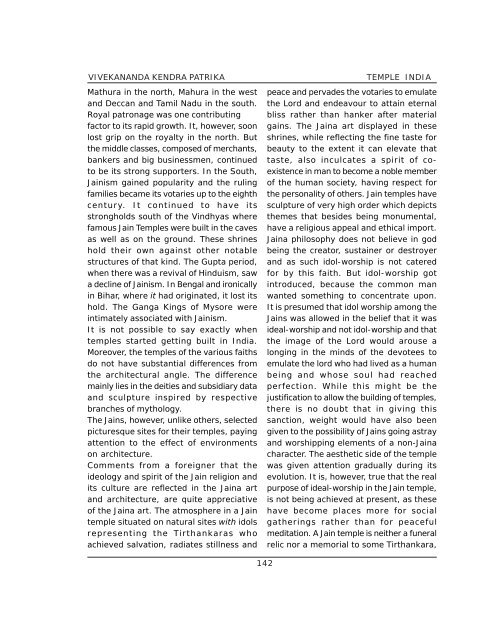Temples In India-1.pdf - Vivekananda Kendra Prakashan
Temples In India-1.pdf - Vivekananda Kendra Prakashan
Temples In India-1.pdf - Vivekananda Kendra Prakashan
You also want an ePaper? Increase the reach of your titles
YUMPU automatically turns print PDFs into web optimized ePapers that Google loves.
VIVEKANANDA KENDRA PATRIKAMathura in the north, Mahura in the westand Deccan and Tamil Nadu in the south.Royal patronage was one contributingfactor to its rapid growth. It, however, soonlost grip on the royalty in the north. Butthe middle classes, composed of merchants,bankers and big businessmen, continuedto be its strong supporters. <strong>In</strong> the South,Jainism gained popularity and the rulingfamilies became its votaries up to the eighthcentury. It continued to have itsstrongholds south of the Vindhyas wherefamous Jain <strong>Temples</strong> were built in the cavesas well as on the ground. These shrineshold their own against other notablestructures of that kind. The Gupta period,when there was a revival of Hinduism, sawa decline of Jainism. <strong>In</strong> Bengal and ironicallyin Bihar, where it had originated, it lost itshold. The Ganga Kings of Mysore wereintimately associated with Jainism.It is not possible to say exactly whentemples started getting built in <strong>In</strong>dia.Moreover, the temples of the various faithsdo not have substantial differences fromthe architectural angle. The differencemainly lies in the deities and subsidiary dataand sculpture inspired by respectivebranches of mythology.The Jains, however, unlike others, selectedpicturesque sites for their temples, payingattention to the effect of environmentson architecture.Comments from a foreigner that theideology and spirit of the Jain religion andits culture are reflected in the Jaina artand architecture, are quite appreciativeof the Jaina art. The atmosphere in a Jaintemple situated on natural sites with idolsrepresenting the Tirthankaras whoachieved salvation, radiates stillness andTEMPLE INDIApeace and pervades the votaries to emulatethe Lord and endeavour to attain eternalbliss rather than hanker after materialgains. The Jaina art displayed in theseshrines, while reflecting the fine taste forbeauty to the extent it can elevate thattaste, also inculcates a spirit of coexistencein man to become a noble memberof the human society, having respect forthe personality of others. Jain temples havesculpture of very high order which depictsthemes that besides being monumental,have a religious appeal and ethical import.Jaina philosophy does not believe in godbeing the creator, sustainer or destroyerand as such idol-worship is not cateredfor by this faith. But idol-worship gotintroduced, because the common manwanted something to concentrate upon.It is presumed that idol worship among theJains was allowed in the belief that it wasideal-worship and not idol-worship and thatthe image of the Lord would arouse alonging in the minds of the devotees toemulate the lord who had lived as a humanbeing and whose soul had reachedperfection. While this might be thejustification to allow the building of temples,there is no doubt that in giving thissanction, weight would have also beengiven to the possibility of Jains going astrayand worshipping elements of a non-Jainacharacter. The aesthetic side of the templewas given attention gradually during itsevolution. It is, however, true that the realpurpose of ideal-worship in the Jain temple,is not being achieved at present, as thesehave become places more for socialgatherings rather than for peacefulmeditation. A Jain temple is neither a funeralrelic nor a memorial to some Tirthankara,142
















